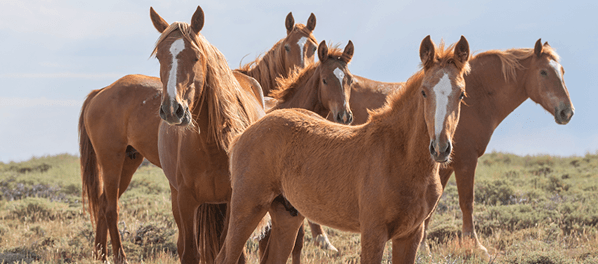
Sanctuary
Across 2,300 acres of California's Central Coast, Return to Freedom provides lifelong refuge for more than 460 wild horses and burros displaced by roundups and neglect. Our sanctuaries allow them to live in natural social herds while modeling humane, sustainable management practices for public lands.

Lompoc Sanctuary
At RTF's 300-acre headquarters sanctuary in Lompoc, wild horses and burros live in natural family bands along California’s Central Coast. This site serves as both a working sanctuary and the heart of RTF’s public engagement—home to guided tours, family programs, and volunteer days that invite visitors to experience the beauty and intelligence of wild herds up close. It also houses ambassador horses like Spirit, the real-life inspiration for DreamWorks’ Spirit: Stallion of the Cimarron, as well as several rare heritage herds, including the Choctaw and Mission horses. Beyond being a refuge, the Lompoc sanctuary anchors RTF’s broader mission—serving as the operational and educational hub for its national rescue and advocacy work.

San Luis Obispo Sanctuary
Spanning 2,000 acres of rolling coastal rangeland, RTF's San Luis Obispo sanctuary is home to the majority of the organization’s rescued wild horses and burros. Managed through regenerative grazing and holistic land practices, this site demonstrates how wild equines can help heal the land—restoring native grasses, improving soil health, and maintaining ecological balance. Family bands roam freely across expansive pastures, living as close to wild as possible while remaining safe from roundups and slaughter. The San Luis Obispo sanctuary reflects RTF’s vision for the future of sanctuary care: sustainable, large-scale, and rooted in harmony between wild herds and the ecosystems that sustain them.
Costs of Running Our Sanctuaries

$550,000
on hay for the horses
This includes the hay and feed required to care for over 460 rescued wild horses and burros at our Lompoc headquarters and San Luis Obispo satellite sanctuary. Many of these animals once faced roundups, neglect, or the threat of slaughter. At Return to Freedom, they now live safely in natural family bands, grazing freely on open pastures.

$1,150,000
on daily care, staffing, land and infrastructure maintenance
Caring for over 460 wild horses and burros takes an extraordinary effort. This amount covers the hands-on work of our staff, land management across Lompoc and San Luis Obispo, and the ongoing upkeep of barns, fences, and water systems that keep the herds safe.
Our Rescues

Texas Burro Rescue (2023)
RTF saved the “Texas Ten,” a group of burros bound for slaughter, along with others in similar peril.
These rescues expanded RTF's care to 42 burros now living safely on sanctuaries and partner
lands—highlighting the organization's commitment to both wild horses and burros across the West.

The Beginning: The Hart Mountain Rescue (1998-1999)
Return to Freedom's work began with the 1998 removal of wild horses from Oregon's Hart Mountain
National Antelope Refuge. More than 270 horses were captured and dispersed through government
auctions, breaking apart entire family bands. RTF stepped in to provide sanctuary for a group
of these displaced horses—reuniting natural herds and giving them a permanent home. This
rescue became the cornerstone of RTF's mission: to protect the freedom, diversity, and social
bonds of America's wild horses through humane, sustainable alternatives to capture and confinement.

Santa Barbara County Seizure (2003)
In one of the largest equine rescues in California's history, RTF partnered with county officials
to care for over 425 neglected and starving horses seized from a local ranch. Within days, RTF
mobilized emergency crews, coordinated medical care, and provided refuge for many of the animals.
This response helped establish RTF as a trusted national voice in large-scale rescue and
rehabilitation.
Growing Need For a New Sanctuary
Return to Freedom's sanctuaries have reached their capacity. Each year, more wild horses and burros are displaced by government roundups or crisis situations than we can safely house. While our goal has always been to keep wild horses on the range, the growing number of animals needing immediate refuge underscores an urgent reality: we need more land, more resources, and a stronger foundation to sustain our mission.

Capital Campaign
Through the Wild Horse and Wildlife Conservancy Campaign, we're working to acquire new land and create long-term stability for Return to Freedom's programs. The campaign will permanently secure our founding Lompoc ranch, establish a dedicated endowment to support operations, and acquire a larger sanctuary to expand habitat, integrate regenerative grazing, and provide space for displaced herds.
Learn More About the Capital Campaign

Planned Giving
Planned giving ensures that the work of today endures tomorrow. Through bequests, trusts, or endowment gifts, supporters can help Return to Freedom acquire new land, improve sanctuary infrastructure, and sustain long-term care for rescued herds. These legacy commitments are investments in permanence—preserving open land, freedom, and the bond between horses and the wild places they call home.
Learn More About Planned Giving
Sanctuary News

Gallium est in elementis
Quod licet Iovi, non licet homini
September 20, 2025

Bloodhorse Daily
Mustang Movie a Fine Fit With SAFE ACT Campaign
September 20, 2025

Lorem Ipsum
Lorem Ipsum Dolor Sit Amet
September 20, 2025